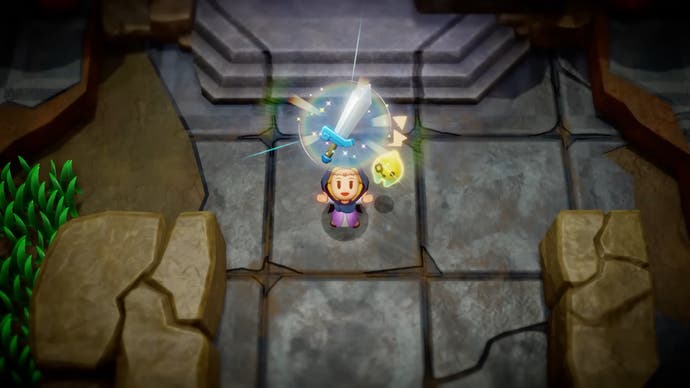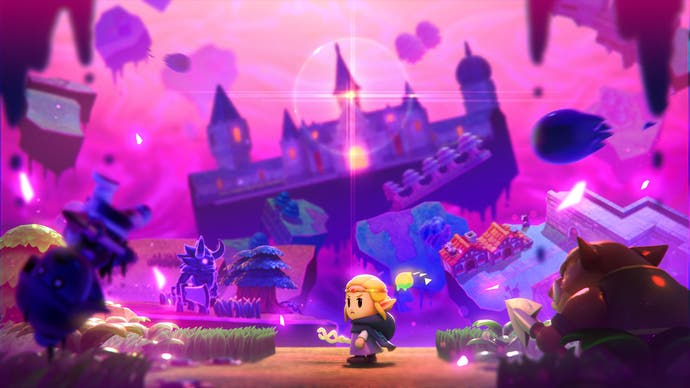The Legend of Zelda: Echoes of Wisdom reinvents age-old gameplay, as the series finally changes its star
Royal treatment.
More than 35 years after the first Legend of Zelda, one of video gaming's most recognisable names will finally front an adventure of her own. Fans have clamoured to play as Zelda for years, of course, and yet Nintendo has previously resisted, keeping Link as the silent avatar of players' adventures.
That all changes in the upcoming The Legend of Zelda: Echoes of Wisdom - the reveal of which this year was one of Nintendo's biggest surprises for some time. Why has it taken so long for Zelda to be the star? The answer, I think, lies in something I find even more remarkable than simply controlling the series' princess, and something which guarantees this isn't just another Zelda with an alternate silent hero - the game-changing Echo ability.
Early on, as Zelda attempts to escape the dungeons of Hyrule Castle, she dons a cloak previously worn by Link and is briefly mistaken for him. At any second, I was expecting her to produce the Master Sword from a hidden pocket and start swinging. But Echoes of Wisdom is not that kind of game - and is all the better for it.
Where Link's most common starting item is typically something to start hitting enemies with, Zelda's fancy new Tri Rod tool allows you to conjure up Echoes of objects you have seen previously. In video game terms, you don't have a weapon per se, but a toolkit with which to solve a problem - a puzzle or group of enemies that need clearing - through other means. And what means! You quickly amass a library of in-game assets available to spawn and despawn into and out of being, from garden variety objects such as barrels and boulders to every kind of enemy you encounter.
There's a playfulness here, a sense that experimentation is something to be encouraged. Need to cross a gap? One of the first Echoes you can access is a bed, perfect for bridging spaces and walking across. (You can also choose to use it for a quick nap.) Need some cover to hide in, as enemies near your position? Wave the Tri Rod to summon a large potted plant to duck behind.
Your new magical staff is powered by Tri, the Zelda series' latest companion character, and one you'll want to keep an eye on. Tri's pixel-like tail indicates how many Echoes you can create at any one time (you start the game able to conjure three at once, but it looks like this will be upgradable). As each Echo is created, Tri's tail shortens. When you remove that Echo, it grows back. It's a handy visual guide for how many more Echoes you have to play with.

Echoes provide you with a range of options with which to solve puzzles, further explore and do battle, and the system feels both powerful and inventive. Being attacked by a flying bat enemy? Call upon a Moblin with a bow and arrow to shoot it down. Alternatively, though, you could pop down a spiny-shelled critter in front of you and watch the bats divebomb that instead, finishing themselves off.
Bat enemies can be used for gliding. Spiders can be used to ascend their dangling silk threads. At one point, I acquired the Echo for a giant slab of meat - with the hint it'd be useful to distract a certain type of enemy in the future. I would later summon up the meat to feed an enemy I thought would love it, only to see them ignore the meal. Still, having that giant steak lying there meant I'd accidentally penned the enemy in, allowing me to fire off an armadillo enemy that pinballed off of surfaces, crashing around the meat to flatten everything in its path.
The Echoes system gets deeper, too - thanks to the inclusion of physics and elemental systems that might seem more at home in Breath of the Wild. Heavy boulders placed on top of breakable objects won't necessarily crush what's underneath, for example, but summoning them while up high then heaving them down on top of something breakable (or directly onto an enemy) below will do the job, thanks to their momentum.
Using the Bind power you unlock in the game's first dungeon, you can move large objects in the game's world or Echoes you have summoned from afar. At one point, I learned the Echo of a fiery enemy, and then realised I needed to burn some crates to progress. Being able to pick up the fiery enemy using Bind was a far better option than trying to pick it up myself and getting burned, I quickly discovered.
For a veteran Zelda fan, the ability to spawn in-game assets and create a small troop of enemies to do your bidding felt like I was playing a version of the game with cheat codes. Wonder who would win between a Darknut enemy and a pack of Moblins? Summon the latter up as Echoes and then sit back to find out. Perhaps the most outlandish moment for me, as someone who still has every inch of Koholint Island memorised, was when I gained the ability to Echo a child's trampoline. Seconds later, I'd found I could now land on top of the previously-unreachable treetops and roofs of houses, something that would have astounded the younger version of me replaying Link's Awakening for the umpteenth time.
While Echoes feel remarkable, Nintendo has balanced their introduction with a game that otherwise still has the feel of a classic top-down Zelda. Ignoring the series' labyrinthine timeline, this is quite clearly a sequel to the Nintendo Switch remake of Link's Awakening in technical terms, with many familiar enemies and elements, the same visual design and the same underlying game engine (with the associated frame-rate slowdown sadly still present, too). There are side-scrolling platform sections (though I saw no goombas). You can still spin to cut grass.

Echoes of Wisdom's dungeons are also fairly traditional, and appear to take place within the rifts which have covered Hyrule, in a location Nintendo has dubbed the Still World. Inside, you initially have to navigate areas where Zelda must hop between broken chunks of landmass that look a little like Dragon Age's Fade. But before too long you find yourself in more familiar surroundings - clearing rooms with distinct puzzles, navigating around via a dungeon map.
And then there's Swordfighter Mode, the introduction of which does allow Zelda to finally wield a blade. After such a captivating introduction to Echoes as the way you interact with the game's world, part of me wondered what the point was of Zelda's sword (it's the sharp end). But this option feels different enough - a time-limited effect to let you attack directly until you deplete an upgradable bar of energy - and gives the princess another power in her arsenal.
It may have taken decades, but Nintendo has finally found an answer to those calls to play as Zelda - with gameplay that feels different enough that this could never be just another Link adventure. At the same time, brilliantly, Echoes of Wisdom manages to still feel like a proper Zelda game - rather than being a more forgettable princess-led spin-off, such as Princess Peach: Showtime. I simply can't wait to see more of Echoes of Wisdom, a game that hosts the inventiveness of Tears of the Kingdom but within perhaps more manageable limits, that wraps this in the DNA of classic top-down entries such as Link's Awakening - and most importantly of all, looks set to stand on its own as a remarkable entry in the series' main canon. Finally, this is Zelda's moment to shine.










